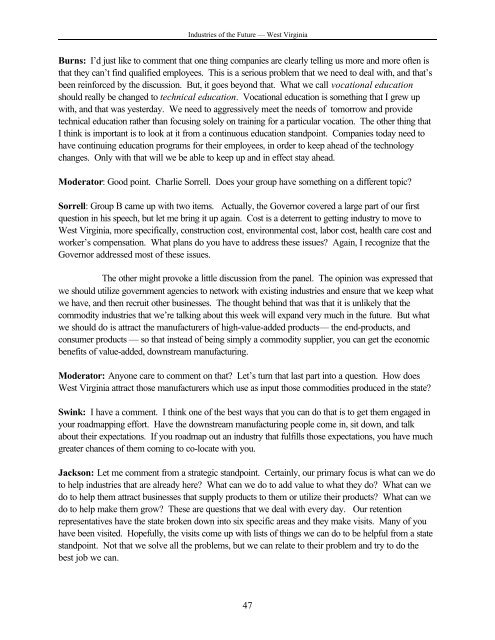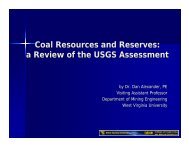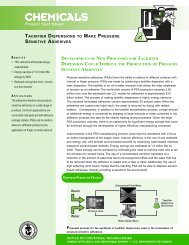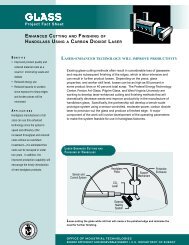PROCEEDINGS - Industries of the Future - West Virginia - West ...
PROCEEDINGS - Industries of the Future - West Virginia - West ...
PROCEEDINGS - Industries of the Future - West Virginia - West ...
You also want an ePaper? Increase the reach of your titles
YUMPU automatically turns print PDFs into web optimized ePapers that Google loves.
<strong>Industries</strong> <strong>of</strong> <strong>the</strong> <strong>Future</strong> — <strong>West</strong> <strong>Virginia</strong><br />
Burns: I’d just like to comment that one thing companies are clearly telling us more and more <strong>of</strong>ten is<br />
that <strong>the</strong>y can’t find qualified employees. This is a serious problem that we need to deal with, and that’s<br />
been reinforced by <strong>the</strong> discussion. But, it goes beyond that. What we call vocational education<br />
should really be changed to technical education. Vocational education is something that I grew up<br />
with, and that was yesterday. We need to aggressively meet <strong>the</strong> needs <strong>of</strong> tomorrow and provide<br />
technical education ra<strong>the</strong>r than focusing solely on training for a particular vocation. The o<strong>the</strong>r thing that<br />
I think is important is to look at it from a continuous education standpoint. Companies today need to<br />
have continuing education programs for <strong>the</strong>ir employees, in order to keep ahead <strong>of</strong> <strong>the</strong> technology<br />
changes. Only with that will we be able to keep up and in effect stay ahead.<br />
Moderator: Good point. Charlie Sorrell. Does your group have something on a different topic?<br />
Sorrell: Group B came up with two items. Actually, <strong>the</strong> Governor covered a large part <strong>of</strong> our first<br />
question in his speech, but let me bring it up again. Cost is a deterrent to getting industry to move to<br />
<strong>West</strong> <strong>Virginia</strong>, more specifically, construction cost, environmental cost, labor cost, health care cost and<br />
worker’s compensation. What plans do you have to address <strong>the</strong>se issues? Again, I recognize that <strong>the</strong><br />
Governor addressed most <strong>of</strong> <strong>the</strong>se issues.<br />
The o<strong>the</strong>r might provoke a little discussion from <strong>the</strong> panel. The opinion was expressed that<br />
we should utilize government agencies to network with existing industries and ensure that we keep what<br />
we have, and <strong>the</strong>n recruit o<strong>the</strong>r businesses. The thought behind that was that it is unlikely that <strong>the</strong><br />
commodity industries that we’re talking about this week will expand very much in <strong>the</strong> future. But what<br />
we should do is attract <strong>the</strong> manufacturers <strong>of</strong> high-value-added products— <strong>the</strong> end-products, and<br />
consumer products — so that instead <strong>of</strong> being simply a commodity supplier, you can get <strong>the</strong> economic<br />
benefits <strong>of</strong> value-added, downstream manufacturing.<br />
Moderator: Anyone care to comment on that? Let’s turn that last part into a question. How does<br />
<strong>West</strong> <strong>Virginia</strong> attract those manufacturers which use as input those commodities produced in <strong>the</strong> state?<br />
Swink: I have a comment. I think one <strong>of</strong> <strong>the</strong> best ways that you can do that is to get <strong>the</strong>m engaged in<br />
your roadmapping effort. Have <strong>the</strong> downstream manufacturing people come in, sit down, and talk<br />
about <strong>the</strong>ir expectations. If you roadmap out an industry that fulfills those expectations, you have much<br />
greater chances <strong>of</strong> <strong>the</strong>m coming to co-locate with you.<br />
Jackson: Let me comment from a strategic standpoint. Certainly, our primary focus is what can we do<br />
to help industries that are already here? What can we do to add value to what <strong>the</strong>y do? What can we<br />
do to help <strong>the</strong>m attract businesses that supply products to <strong>the</strong>m or utilize <strong>the</strong>ir products? What can we<br />
do to help make <strong>the</strong>m grow? These are questions that we deal with every day. Our retention<br />
representatives have <strong>the</strong> state broken down into six specific areas and <strong>the</strong>y make visits. Many <strong>of</strong> you<br />
have been visited. Hopefully, <strong>the</strong> visits come up with lists <strong>of</strong> things we can do to be helpful from a state<br />
standpoint. Not that we solve all <strong>the</strong> problems, but we can relate to <strong>the</strong>ir problem and try to do <strong>the</strong><br />
best job we can.<br />
47






